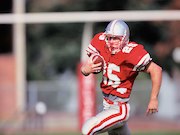Career duration, playing position may modify the effects of concussion history in ex-football players
TUESDAY, Oct. 31, 2017 (HealthDay News) — For former collegiate and professional football players, career duration and primary playing position appear to modify the effects of concussion history on white matter structure and neural recruitment, according to a study published online Oct. 31 in Radiology.
Michael D. Clark, from the University of North Carolina at Chapel Hill, and colleagues examined the correlation between exposure to concussive and subconcussive head impacts, white matter integrity, and functional task-related neural activity in 61 cognitively unimpaired former collegiate and professional football players (ages, 52 to 65 years).
The researchers identified a significant interaction between career duration and concussion history; lower fractional anisotropy (FA) was seen in a broadly distributed area of white matter among former college players with more than three versus zero to one concussion, but the opposite was seen for former professional players. There was a separate interaction between concussion history and position: lower FA was seen in frontal white matter for nonspeed players with more than three versus zero to one concussion. A similar interaction between concussion history and position was seen in an analysis of working memory-task blood oxygen level-dependent (BOLD) percent signal change (PSC). Across three levels of a working memory task, former players with lower FA tended to have lower BOLD PSC.
“The differences in brain structure and function were observed in the absence of clinical impairment, which suggested that multimodal imaging may provide early markers of onset of traumatic neurodegenerative disease,” the authors write.
Copyright © 2017 HealthDay. All rights reserved.








